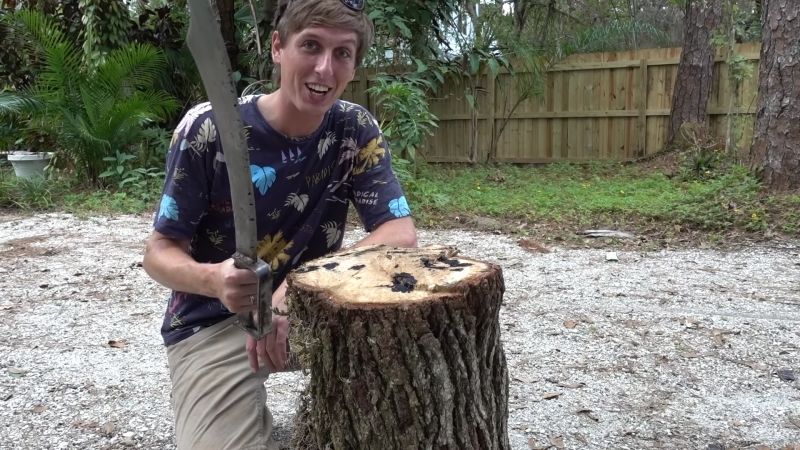Thermite can cut cars in half but [TheBackyardScientist] relies on its ability to create rather than destroy. In fact, thermite was the key component when he casts a solid metal sword. The casting doesn’t require a furnace since the heat is produced by the thermite itself.
In case it wasn’t abundantly clear: this procedure is not without risk.
[TheBackyardScientist] compares two types of iron oxide, red and black, then judges their usability based on the post-ignition mass. His goal is to get the most metal from a single reaction. He also adds some stainless steel beads to improve the quality of the casting and to utilize some of the excess heat.
With encouragement from his neighbors and a couple of trials with fire bricks, buckets, and sand, [TheBackyardScientist] is successful. The resulting sword is treated, given a handle, sharpened, then scientifically tested with a variety of things found in a regular kitchen.
If you look in the background of [TheBackyardScientist]’s workshop, you may notice his molten PEWter gun. This steel sword is an upgrade from his recycled pewter sword a few years ago.
Thank you, [Keith Olson] for another great tip.















WOW! Just WOW!
What other (unintended) uses for thermite are there?
Something like thermite can have intended and unintended uses?
Mostly unintended results.
I forgot to say that I love the art of this! It’s like sticking a rock in a dragon’s mouth and pulling out a sword.
It can be used for welding copper ground cables to grounding rods in RF antenna and electrical work applications. You can buy kits that contain all of the stuff needed to do this type of “bonding”.
I guess it ensures a solid ground vs. clamping or soldering where even the slightest impedance can be a very bad thing (like in lightning suppression systems)
I’ve heard the kits are expensive though.
Railroad track welding
https://www.youtube.com/results?search_query=thermite+track+welding
Could it work on a small scale? Like, using a trail of miniature specks of thermite to make a weld comparable to usual methods.
Thermite on a small scale is very hard to control. I’ve tried to make a small “wand” of thermite but when it was upside-down, it didn’t want to keep flame. Probably to keep going, it needs to have some molten metal on top.
Yah, you’ve got that surface area to volume thing screwing you up. What puts thermite out is taking the heat out of it so it can’t sustain the reaction, on a small scale surface area lets more heat escape than it’s generating so reaction fizzles out. Need to keep everything as round and short as possible to minimise surface area.
As a side note – did you know dry gypsum can burn in high enough temperature? Like when some molten iron from thermite wand goes into gypsum filled handle:
|A|
|A|
|T|
|G|
(A – air, T – thermite, G – gypsum, | – paper pipe). Reaction looked like self-sustaining, 5mm molten iron bead burned through about 5cm of gypsum with a very nice flame.
This is great to see in action. In 1994, speaking to my sculpture professor in Pennsylvania, I expressed an interest in using thermite to create large sculptures. Here’s the really messed up part: my sculpture teacher’s name was Professor Olson! ????
Heh, what neighbor doesn’t love a mini-mushroom cloud?
An upstairs neighbor.
Tbh Downstairs Neighbours don’t love the fact thermite is eating through the celing either! Just can’t win!
Bomb squad??? Better that, than them doing TS ops maybe?
Great job. Those imperfections just add to the effect anyone can buy a perfect looking sword. Sweet!
holy hell, he lit the thing and all I could think is he left his damn propane in the splash zone.
These videos make a strong case for the safety triangle being a submerged iceberg with most of the lower levels omitted and skipping right up to the near-severe-injury/fatality level.
there are similar moments of ‘oh my!’ in his other videos as well.
Very cool! Nice job :)
I first though it involved termites, you have no idea how confused I was.
its not a sword.. more a falchion or something, but its cool anyway
Maybe a cutlass?
Yes, very cutlassy.
a falchion is a type of sword, as is a rapier, scimitar, flamberge, etc.
Try with green sand and sand castings with adhesive. I wonder how that would work due to the pressure of the chemical reaction and de-gassing. Maybe pour into the bricks at an angle to flow the molten metal into the green sand form. I’m guessing the author of the video knows this can be better because he does seem to know about the casting process and the metal formed funky due to gas issues.
Man, this looks awesome still as I was wanting to put together a foundry with a spherical kiln I designed to have multiple uses. I also am wondering about using with ceramics or hybrid materials. I’d be to nervous to use in the kiln though since I’d have to detail and comprehend all the variables of the system of which are somewhat noted in the video.
Maybe an easier way to make custom alloys also. Sure beats ICP or Arc for ease of setup and all that energy input system. Awesome!